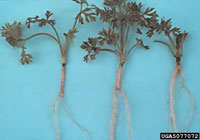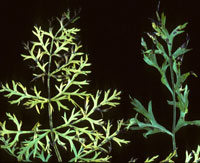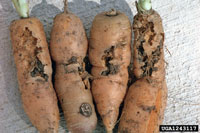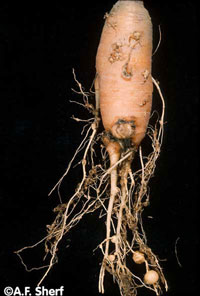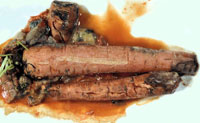Extension > Garden > Diagnose a problem > What's wrong with my plant? > Vegetable > Carrot > Leaves wilt
Carrot > Leaves > Leaves wilt
1 of 5
Pythium root dieback
Pythium spp.
- Carrot top may yellow and wilt if root damage is severe
- Carrot root is short stunted and may be forked or misshapen
- Horizontal lesions (1/10 cm to 1 cm) may appear on the surface of the root
- Common in heavy wet soils and organic soils
- More information on Pythium root dieback
2 of 5
Bacterial leaf blight
Xanthomonas campestris pv. Carotae
- Severely infected leaves, yellow, wilt and die
- Leaf spots start small, circular, light brown to tan
- Eventually spots become elongate; dark brown with yellow edges
- Infection progresses down the leaf
- Lower leaf surface is very shiny, and may be sticky in wet weather
- Young leaves can become distorted
- Roots are not directly infected, but may be small due to severe leaf damage
- More information on Bacterial Leaf Bight
3 of 5
Carrot weevil
Listronotus oregonensis
- Leaves can wilt
- Small, circular, dark egg laying scars on leaf petiole
- Tunneling and holes in carrot roots
- Larvae are legless, cream colored, C-shaped grubs, up to 1/3 inch long
- Adults are dark-brown, less than 1/4 inch long, and have a snout
- Present throughout the growing season
4 of 5
Northern root knot nematode
Meloidogyne hapla
- In severely infected plants, carrot tops may be stunted, yellow, and wilt during the day
- Tap root is stunted, deformed, or forked
- Many fibrous roots may be present
- Many small round to irregular lumps and swellings can be found on both the tap root and fibrous roots
- More information on Northern Root Knot Nematode
5 of 5
Bacterial soft rot
Erwinia carotovora subsp. Carotovora
- Rotted sections of the root may dissolve into liquid when carrots are pulled
- Dark sunken, soft mushy cavities may form in the root
- Eventually part or all of the root becomes soft, watery, and slimy
- When root damage is severe, leaves turn yellow and wilt
- A foul odor may be present with the rot
- Common in very wet heavy soils
- More information on Bacterial soft rot



